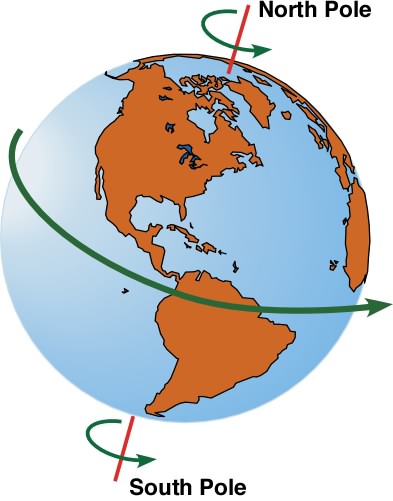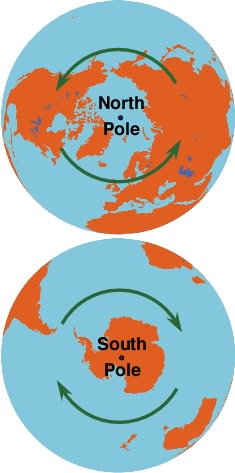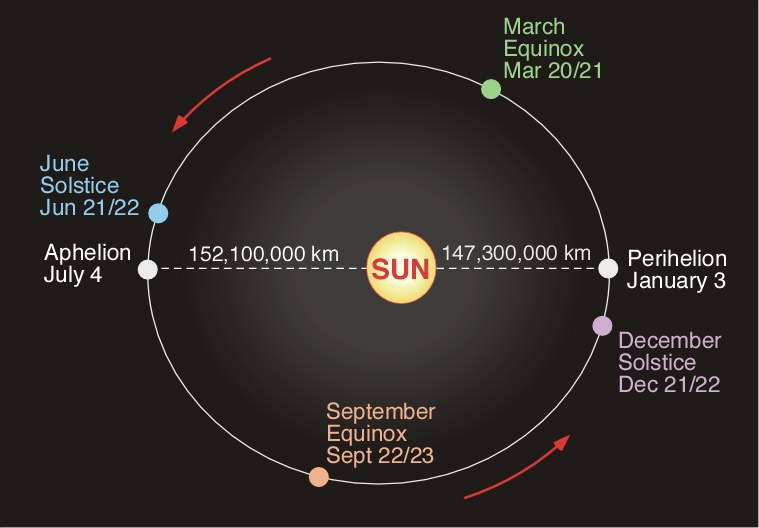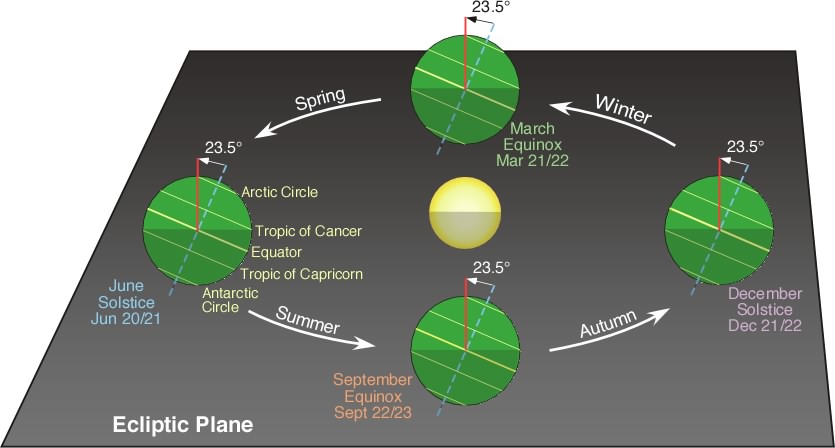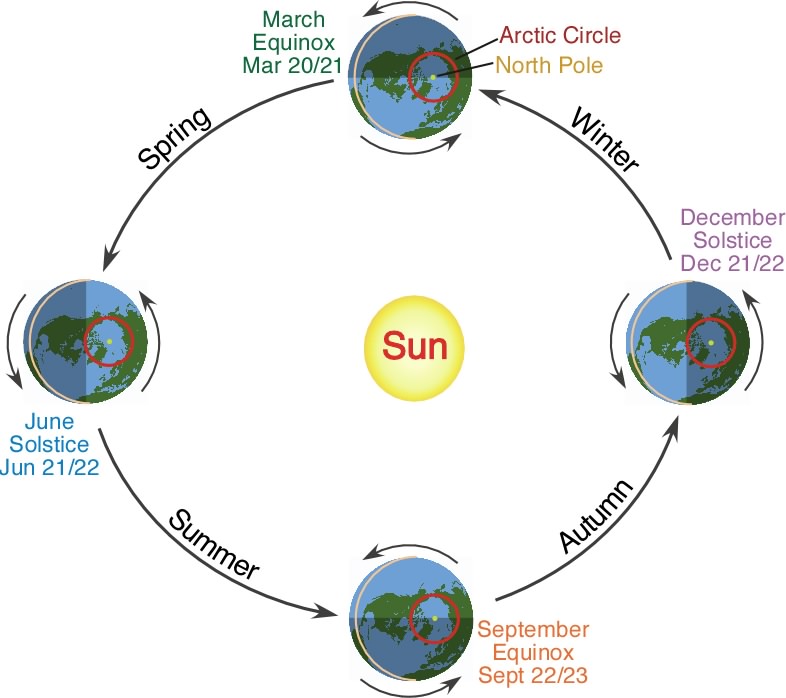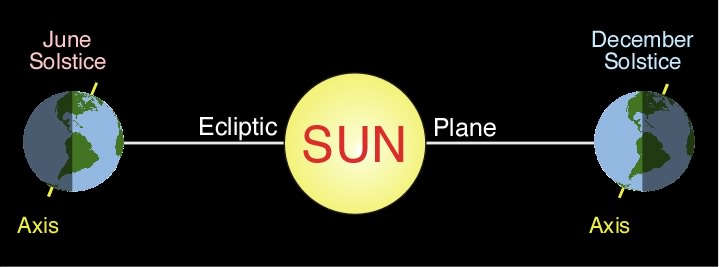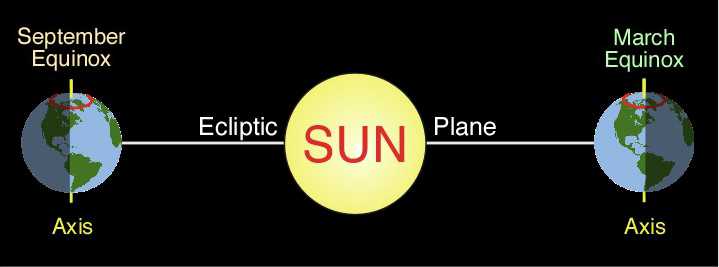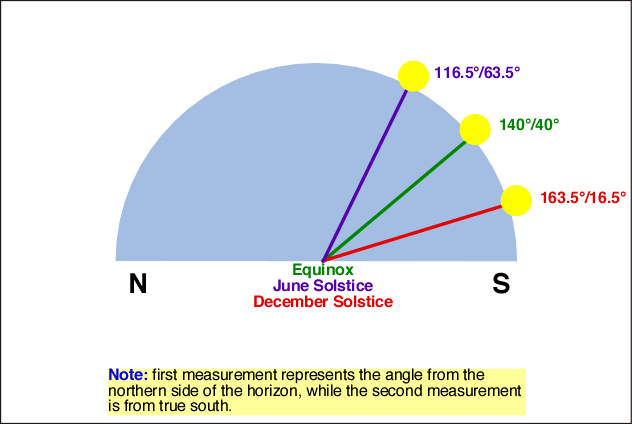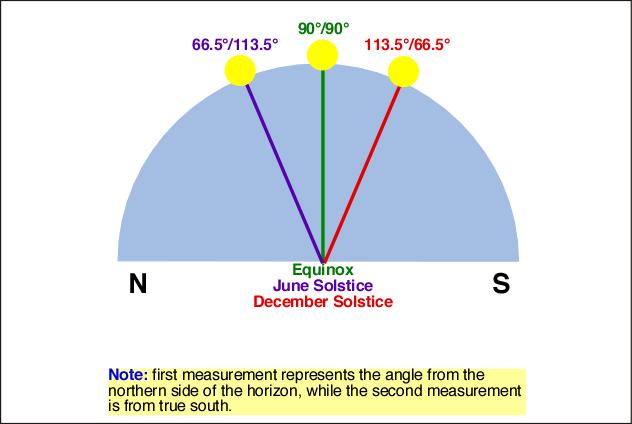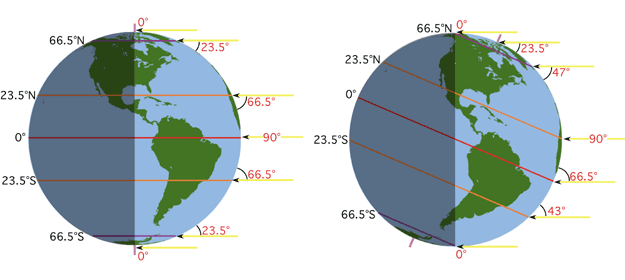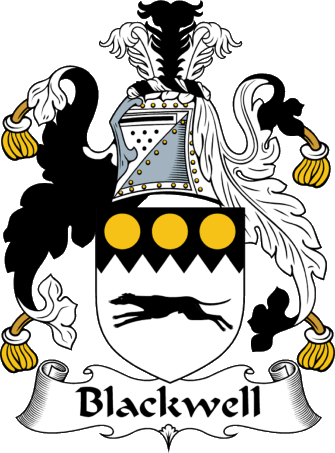| Figure 6h-12: Relationship of maximum Sun height to latitude for the equinox (left) and June solstice (right). The red values on the right of the globes are maximum solar altitudes at solar noon. Black numbers on the left indicate the location of the Equator, Tropic of Cancer (23.5 degrees N), Tropic of Capricorn (23.5 degrees S), Arctic Circle (66.5 degrees N), and the Antarctic Circle (66.5 degrees S). The location of the North and South Poles are also identified. During the equinox, the equator is the location on the Earth with a Sun angle of 90 degrees for solar noon. Note how maximum Sun height declines with latitude as you move away from the Equator. For each degree of latitude traveled maximum Sun height decreases by the same amount. At equinox, you can also calculate the noon angle by subtracting the location's latitude from 90. During the summer solstice, the Sun is now directly overhead at the Tropic of Cancer. All locations above this location have maximum Sun heights that are 23.5 degrees higher from the equinox situation. Places above the Arctic Circle are in 24 hours of daylight. Below the Tropic of Cancer the noon angle of the Sun drops one degree in height for each degree of latitude traveled. At the Antarctic Circle, maximum Sun height becomes 0 degrees and locations south of this point on the Earth are in 24 hours of darkness. |
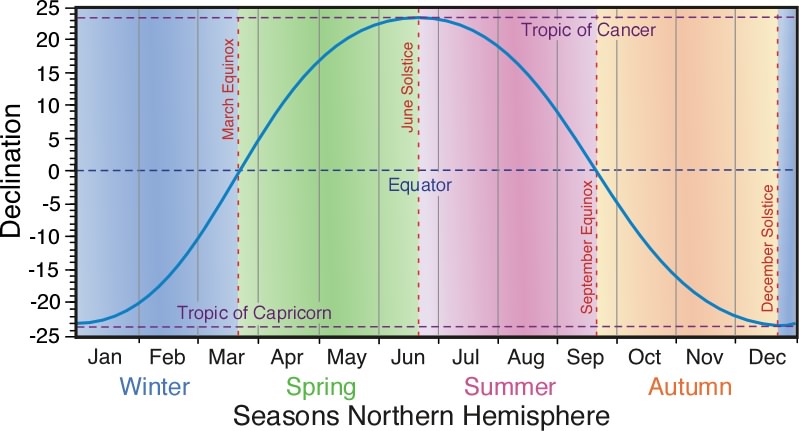
| Figure 6h-13: Angle of the Sun’s declination and latitude of the subsolar point throughout the year. Seasons are for the Northern Hemisphere. |
The following table describes the changes in solar altitude at solar noon for the two solstices and equinoxes. All measurements are in degrees (horizon has 180 degrees from True North to True South) and are measured from either True North or True South (whatever is closer).
| Table 6h-1: Maximum Sun altitudes for selected latitudes during the two solstices and equinoxes. |
|
Location's Latitude |
March Equinox March 20/21 |
June Solstice June 21/22 |
September Equinox September 22/23 |
December Solstice December 21/22 |
| 90 N | 0 degrees | 23.5 degrees | 0 degrees | - 23.5 degrees |
| 70 N | 20 degrees | 43.5 degrees | 20 degrees | -3.5 degrees |
| 66.5 N | 23.5 degrees | 47 degrees | 23.5 degrees | 0 degrees |
| 60 N | 30 degrees | 53.5 degrees | 30 degrees | 6.5 degrees |
| 50 N | 40 degrees | 63.5 degrees | 40 degrees | 16.5 degrees |
| 23.5 N | 66.5 degrees | 90 degrees | 66.5 degrees | 43 degrees |
| 0 degrees | 90 degrees | 66.5 degrees | 90 degrees | 66.5 degrees |
| 23.5 S | 66.5 degrees | 43 degrees | 66.5 degrees | 90 degrees |
| 50 S | 40 degrees | 16.5 degrees | 40 degrees | 63.5 degrees |
| 60 S | 30 degrees | 6.5 degrees | 30 degrees | 53.5 degrees |
| 66.5 S | 23.5 degrees | 0 degrees | 23.5 degrees | 47 degrees |
| 70 S | 20 degrees | -3.5 degrees | 20 degrees | 43.5 degrees |
| 90 S | 0 degrees | - 23.5 degrees | 0 degrees | 23.5 degrees |
The following links show graphical illustrations of the annual movements of the Sun in our skies for selected latitudes. In these illustrations, solar angles are measured from both True North and True South for solar noon.
| 90 N | 66.5 N | 50 N | 23.5 N | Equator (0) | 23.5 S | 50 S | 66.5 S | 90 S |
Finally, the altitude of the Sun at solar noon can also be calculated with the following simple equation:
Altitude A = 90 - Latitude L +/- Declination D
In this equation, L is the latitude of the location in degrees and D is the declination. The equation is simplified to A = 90 - L if Sun angle determinations are being made for either equinox date. If the Sun angle determination is for a solstice date, declination (D) is added to latitude (L) if the location is experiencing summer (northern latitudes = June solstice; southern latitudes = December solstice) and subtracted from latitude (L) if the location is experiencing winter (northern latitudes = December solstice; southern latitudes = June solstice). All answers from this equation are given relative to True North for southern latitudes and True South for northern latitudes. For our purposes only the declinations of the two solstices and two equinoxes are important. These values are: June solstice D=23.5, December solstice D=23.5, March equinox D=0, and Septemeber equinox D=0. When using the above equation in tropical latitudes, Sun altitude values greater than 90 degrees may occur for some calculations. When this occurs, the noonday Sun is actually behind you when looking towards the equator. Under these circumstances, Sun altitude should be recalculated as follows:

